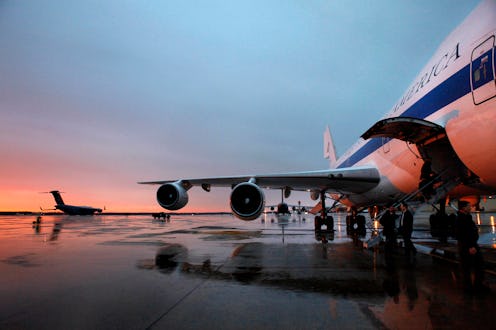News
Would You Fly On A Standing-Only Plane?
Well, we've got good and bad news. On the one hand, France-based airplane parts manufacturer Airbus has submitted a European patent on a new type of bicycle-style seating for Airbus planes, which rejects even the comfort and convenience of a headrest. On the other hand, a new report in the International Journal of Engineering and Technology (IACSIT) found that introducing standing-only sections for airlines could drop ticket prices up to 44 percent. So, your holiday could get a lot cheaper — except you might have to stand up (or sit awkwardly on a bicycle-type chair) the whole way there. Hmm.
You might instinctively assume these ideas are new, and while that might be said for Airbus' new patents, the effort to get flyers on their feet has been considered before. In 2012 Michael O'Leary, CEO of the infamously cheap Euro-airline Ryanair, floated the idea of sticking standing passengers in the back of his planes.
But, due to what he considered onerous seatbelt rules — "Seat belts don't matter. You don't need a seatbelt on the London Underground. You don't need a seatbelt on trains which are traveling at 120 mph and if they crash you're all dead," he said — the plan wasn't ready to fly. (Pun intended.)
If passengers were allowed — or rather, forced — to stay on their feet for the duration of a flight, it could potentially have both positive and negative impacts on health. On the one hand, one of the most serious in-air medical conditions that the CDC advises caution about is deep vein thrombosis, the formation of a blood clot primarily in the legs which trigger a pulmonary embolism. Lengthy trips sitting in cramped spaces can increase risk for DVT, and getting up to walk around periodically is encouraged to minimize your risks. So, if you're standing up the whole time, you'd probably be in better shape that way.
But you'll probably be standing up for a long time, and it'll feel even longer. When runway taxiing and landing procedures are factored in, how many of us have honesty been on flights that would've been less than an hour of standing in place? And, obviously, those of us not exactly in shape, or nursing leg or back injuries, need not apply.
Airbus' patent, on the other hand, seems less beneficial, bar tighter spaces and, ostensibly, lower-cost travel. The new seats, which literally are imagined as bicycle seat-shaped, achieve a more upright sort of posture, but frankly, not one that looks very comfortable.
This doesn't look very accommodating for heavier passengers, and would lack even the barest amenities of a conventional coach-class ticket — you have no headrest to allow you to snooze, no tray table in front of you, just the tiniest of seats and back supports to keep you upright. And according to the Los Angeles Times, the scheme leaves very little legroom, which can be pretty bad for your health. If I had to make the call, honestly, I'd be standing in the back.
It also bears mentioning that once an airline sets a new standard, and sees that it's successful and profitable, there's no guarantee that the massively lower price will stick. The hefty baggage fees you now have to pay, after all, were ostensibly put in place to combat soaring oil prices in the pre-2010s. But when those prices came down, oddly enough, the baggage fees didn't.
Images: Getty Images (2)
